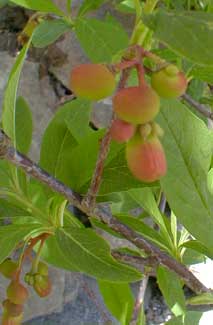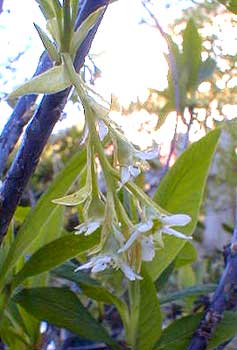
Indian Plum;
or, Oso Berry
"Plum blossoms soften a stone wall,
give warmth to the moon."
-Tony Black Feather
(1934-2004)
(1934-2004)
Because the male & female of the Indian Plum (Oemleria cerasiformis) are separate trees, room is required for at least two of them, & if there's room for two or three females & one male, that's cool too. The damnable thing is nurseries almost never sell them sexed.
We got our pair from a local native plants specialist & the female was obvious because you could already see evidence of the fruits getting started as the flowers were fading away (this was toward the end of March). The other we took a stab at "guessing" was male by looking for male parts in its March flowers (shown in the second photo much larger than life size).
 The individual blooms were too small for certainty, but we figured if we guessed wrong & actually got two females, there was room for a third bush & next time we would have a magnifying glass to identify the male, which has fifteen stamins so looks quite different inside from the females with only five carpels. One can also try to judge the sexes by the smell; male flowers smell bad, female flowers smell good; but on the rainy day we were in the nursery, none of the flowers had any odor at all.
The individual blooms were too small for certainty, but we figured if we guessed wrong & actually got two females, there was room for a third bush & next time we would have a magnifying glass to identify the male, which has fifteen stamins so looks quite different inside from the females with only five carpels. One can also try to judge the sexes by the smell; male flowers smell bad, female flowers smell good; but on the rainy day we were in the nursery, none of the flowers had any odor at all.This large shrub or small tree grows wild in our state in a wide range of conditions, from moist stream banks to rather dry woodland edges & rocky canyons, mainly at low elevations. Its fuller range is all along the coast from British Columbia through western Washington & Oregon & northern California.
It has been grown successfully in zones 6 through 10, though zones 8 & 9 are its favorite. It can be grown in full sun or part shade but ideally has a little protection from afternoon sun. It can tolerate wet or droughty soils but moist humusy acidic soils are best, though slightly alkaline soils won't harm it. Overall, quite adaptable.
Its height is variable depending on conditions; some remain in the six to ten foot range as wide suckering bushes. Some grow fifteen or even twenty feet as small trees. If it is planted in a location where it would've been better if it had stayed smallish, it can be cut back virtually to the ground & will grow back fresh & new.
Most years it will only require a bit of pruning, which is done in spring soon after it has finished flowering. Since it flowers on new wood a degree of pruning is essential.
Racemes of floppy-dangly little white flowers occur in March & April, sometimes as early as February. These can put on a moderately impressive show in late winter. It releafs early, too, so the leaves are coming in alongside the flowers.
Being so early to leaf out, it also early to turn yellow at the end of summer, though the leaves usually hang on until autumn is well started.
The most amazing thing about Indian plum are the plums. They start out greenish, then gain peach-colored highlights & even look like miniature peaches at this stage (as in the April photo above). They slowly ripen to blue. When fully ripened they look like blue Italian prunes but are only the size of the end of one's pinky. There are one to five of the plums per pistillate.
The fruits are rarely harvested for human use because terribly bitter (& potentially toxic) until fully ripe, & a little bitter even when ripe. They were a common harvest for aboriginal peoples, eaten fresh or preserved in bear fat. The bark was used by first peoples to make a tonic tea & laxative.
For today's palates they certainly can be tasty if prepared as cooked, sieved, & sweetened jelly. Birds, squirrels, bears, coyotes, foxes, racoons & deer all eat these fruits. Because birds like them a great deal they don't remain long on the branches, & bird-netting might be required in order to harvest the fruits to make jelly.
The genus name is after German naturalist Augustus Gottlieb Oemler (1774-1852). The species name means "cherry-like." Its common names other than Indian Plum include Oso Berry (or Osoberry) so named because Oso means "Bear" & bears eat them. They're also called Bird Cherry, Oregon Plum, or Skunk Bush. The last name is due to the cat-urine smell of the male flowers; female flowers smell vastly more pleasant (of cucumber). The male's smell is something to bear in mind when deciding where to plant them, not by the front porch, though the offensive smell does not travel far & is no reason to avoid having it altogether.